This is the first in a sequence of four posts taken from my recent report: Why Did Environmentalism Become Partisan?
Introduction
In the United States, environmentalism is extremely partisan.
It might feel like this was inevitable. Caring about the environment, and supporting government action to protect the environment, might seem like they are inherently left-leaning. Partisanship has increased for many issues, so it might not be surprising that environmentalism became partisan too.
Looking at the public opinion polls more closely makes it more surprising. Environmentalism in the United States is unusually partisan, compared to other issues, compared to other countries, and compared to the United States itself at other times.
The partisanship of environmentalism was not inevitable.
Compared to Other Issues
Environmentalism is one of the, if not the, most partisan issues in the US.
The most recent data demonstrating this comes from a Gallup poll from 2023.[1] Of the 24 issues surveyed, “Protecting the Environment Has Priority Over Energy Development” was tied for the largest partisan gap with “Government Should Ensure That Everyone Has Healthcare.” Of the top 5 most partisan issues, 3 were related to environmentalism. The amount this gap has widened since 2003 is also above average for these environmental issues.
Figure 1: The percentages of Republicans and Democrats who agree with each statement shown, 2003-2023. Reprinted from Gallup (2023).
Pew also has some recent relevant data.[2] They ask whether 21 particular policies “should be a top priority for the president and Congress to address this year.” The largest partisan gap is for “protecting the environment” (47 p.p.), followed by “dealing with global climate change” (46 p.p.). These are ten percentage points higher than the next most partisan priority. These issues are less specific than the ones Gallup asked about, and so might not reveal as much of the underlying partisanship. For example, most Democrats and most Republicans agree that strengthening the economy is important, but they might disagree about how this should be done.
Figure 2: The percentages of Republicans and Democrats who believe that each issue should be a top priority. Reprinted from Pew (2023).
Guber’s analysis of Gallup polls from 1990, 2000, & 2010 also shows that environmentalism is unusually partisan.[3] Concern about “the quality of the environment” has a similar partisan gap as concern about “illegal immigration,” and larger than concern about any other political issue. If we hone in on concern about “global warming” within overall environmental concern, the partisan gap doubles, making it a clear outlier.
Figure 3: Difference between the mean response on a four point scale for party identifiers on concern for various national problems in 2010. “I'm going to read you a list of problems facing the country. For each one, please tell me if you personally worry about this problem a great deal, a fair amount, only a little, or not at all.” Reprinted from Guber (2013).
The partisanship of environmentalism cannot be explained entirely by the processes that made other issues partisan. It is more partisan than those other issues. At least this extra partisan gap wants an explanation.
Compared to Other Countries
The United States is more partisan than any other country on environmentalism, by a wide margin.
The best data comes from a Pew survey of “17 advanced economies” in 2021.[4] It found that 7 of them had no significant partisan gap, and that the US had a partisan gap that was almost twice as large as any other country.
Figure 4: Percentages of people with different ideologies who would be willing to make a lot of or some changes to how they live and work to help reduce the effects of global climate change, in 17 different countries. Only statistically significant differences are shown. Reprinted from Pew (2021).
This is evidence that environmentalism is more likely to be left-leaning. The explanation for this might involve something intrinsic to environmentalism itself, or it might involve interactions between countries and shared media environments. But it clearly is possible for environmentalism to remain bipartisan, which has happened in the UK, France, Spain, Japan, South Korea, Taiwan, and Singapore.
The United States is more partisan overall than most other countries, but it is not an outlier. There are other countries with similar levels of overall partisanship,[5] but almost no partisanship in their support for environmentalism: France[6] and South Korea.[7] There is no correlation between overall partisanship and partisanship in environmentalism.[8]
Compared to Other Times
Environmentalism was a bipartisan issue in the United States as recently as the 1980s.
The longest data series for U.S. public opinion on environmentalism comes from the General Social Survey, which has been administered to thousands of Americans for most years between 1974 and 2012.[9]
Figure 5: Percentages of Democrats and Republicans reporting that national spending on the environment is “Too Little,” 1974-2012. Reprinted from McCright et al. (2014).
During the mid-to-late 1970s, support for environmentalism was declining in both parties. Democrats were consistently about 10 percentage points (p.p.) more likely than Republicans to say that there was too little environmental spending.
During the 1980s, support for environmentalism surged. This increase was even larger among Republicans than among Democrats, with the partisan gap closing by the end of the decade.
In the 1990s and 2000s, Democrats’ support for environmentalism remained roughly constant, while Republicans’ support fell dramatically. A large partisan gap opened. The overall support for environmentalism declined, although this might be because support for overall government spending also fell in the early 1990s.[10]
Gallup polling on similar questions only goes back to 1997.[11] It shows an initially modest partisan gap of 15 p.p. in 1997, which grew to an over 50 p.p. gap in 2021.
Figure 6: Percentages of Republicans, Independents, and Democrats who believe that global warming will pose a serious threat to themselves or their way of life, 1997-2021. Reprinted from Gallup (2021).
This change is especially striking because the Republican Party did not change its positions on most issues between the 1980s and 2000s. Underlying principles like small government economics and social conservatism were common to the Republican Party of both decades. The anti-environmentalism of the Republican Party began in the 1990s, clearly after the ‘Reagan Revolution.’
Conclusion
The development of a large partisan gap about environmentalism in the United States was not inevitable. The United States has a smaller partisan gap for most other issues, other countries have less partisanship on this issue (even if the country is very partisan overall), and environmentalism was a bipartisan issue as recently as the 1980s.
This suggests that the explanation for the partisanship does not lie in broad structural or ideological factors that are consistent across many countries and times. Instead, the explanation is likely to be contingent, centered on the choices of individual decision makers.
- ^
Frank Newport. Update: Partisan Gaps Expand Most of Government Power, Climate. Gallup. (2023) https://news.gallup.com/poll/509129/update-partisan-gaps-expand-government-power-climate.aspx.
See also:
Frank Newport & Andrew Dugan. Partisan Differences Growing on a Number of Issues. Gallup (2017) https://news.gallup.com/opinion/polling-matters/215210/partisan-differences-growing-number-issues.aspx.
- ^
Economy Remains the Public’s Top Policy Priority; COVID-19 Concerns Decline Again. Pew Research. (2023) https://www.pewresearch.org/politics/2023/02/06/economy-remains-the-publics-top-policy-priority-covid-19-concerns-decline-again/.
- ^
Deborah Lynn Guber. A Cooling Climate for Change? Party Polarization and the Politics of Global Warming. American Behavioral Scientist 57.1. (2013) p. 93 –115. https://cssn.org/wp-content/uploads/2020/12/A-Cooling-Climate-for-Change-Party-Polarization-and-the-Politics-of-Global-Warming-Deborah-Guber.pdf.
- ^
James Bell, Jacob Poushter, Moira Fagan & Christine Huang. In Response to Climate Change, Citizens in Advanced Economies Are Willing To Alter How They Live and Work. Pew Research. (2021) https://www.pewresearch.org/global/2021/09/14/in-response-to-climate-change-citizens-in-advanced-economies-are-willing-to-alter-how-they-live-and-work/.
- ^
Laura Silver. Most across 19 countries see strong partisan conflict in their society. Pew Research. (2022) https://www.pewresearch.org/short-reads/2022/11/16/most-across-19-countries-see-strong-partisan-conflicts-in-their-society-especially-in-south-korea-and-the-u-s/.
- ^
Macron & Le Pen seem to have fairly similar climate policies. Both want France's electricity to be mostly nuclear – Le Pen more so. Both are not going to raise fuel taxes – Macron reluctantly. Le Pen talks more about hydrogen and reshoring manufacturing from countries which emit more. Macron supports renewables in addition to nuclear power. The various leftists (socialists, greens, and communists run separately in recent elections) seem to be interested in phasing out nuclear & replacing it with renewables. None of the parties dismiss climate change as an issue and all are committed to following international climate agreements.
Kate Aronoff. Marine Le Pen’s Climate Policy Leans Ecofascist. The New Republic. (2022) https://newrepublic.com/article/166097/marine-le-pens-climate-policy-whiff-ecofascism.
- ^
Heesu Lee. Climate Is the New ‘Must-Have’ in South Korean Election Gameplan. Bloomberg. (2024) https://www.bloomberg.com/news/articles/2024-04-04/climate-is-the-new-must-have-in-south-korean-election-gameplan.
- ^
There are 14 countries in both the Pew survey on environmentalism and the Pew survey on overall partisanship. There is no correlation between the fraction of people who say that there are strong or very strong conflicts between people who support different parties in their country vs. the left-right difference between people who say that they are willing to make a lot of or some changes to how they live and work to help reduce the effects of global climate change. https://docs.google.com/spreadsheets/d/1h14JsezOloAUqy78MBo_JPpwiAjUcwQ-z8V5wuihUk8/edit?usp=sharing.
- ^
Aaron M. McCright, Chenyang Xiao, & Riley E. Dunlap. Political polarization on support for government spending on environmental protection in the USA, 1974-2012. Social Science Research 48. (2014) p. 251-260. https://www.sciencedirect.com/science/article/abs/pii/S0049089X1400132X.
- ^
Little Public Support for Reductions in Federal Spending. Pew Research. (2019) https://www.pewresearch.org/politics/2019/04/11/little-public-support-for-reductions-in-federal-spending/.
- ^
Lydia Saad. Global Warming Attitudes Frozen Since 2016. Gallup. (2021) https://news.gallup.com/poll/343025/global-warming-attitudes-frozen-2016.aspx.
Note that there are several similar questions, all which show a small or zero partisan gap when the data starts, which grows dramatically in time.

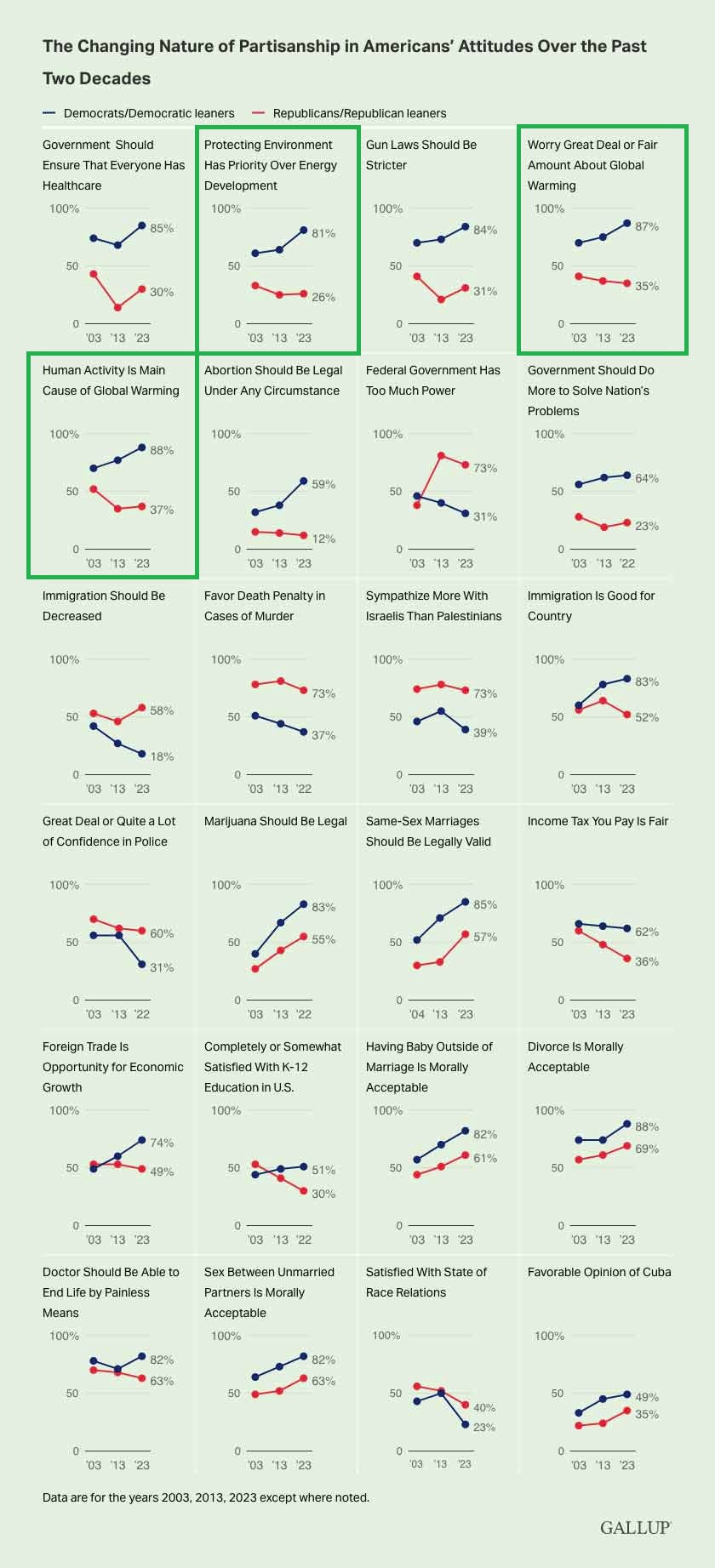
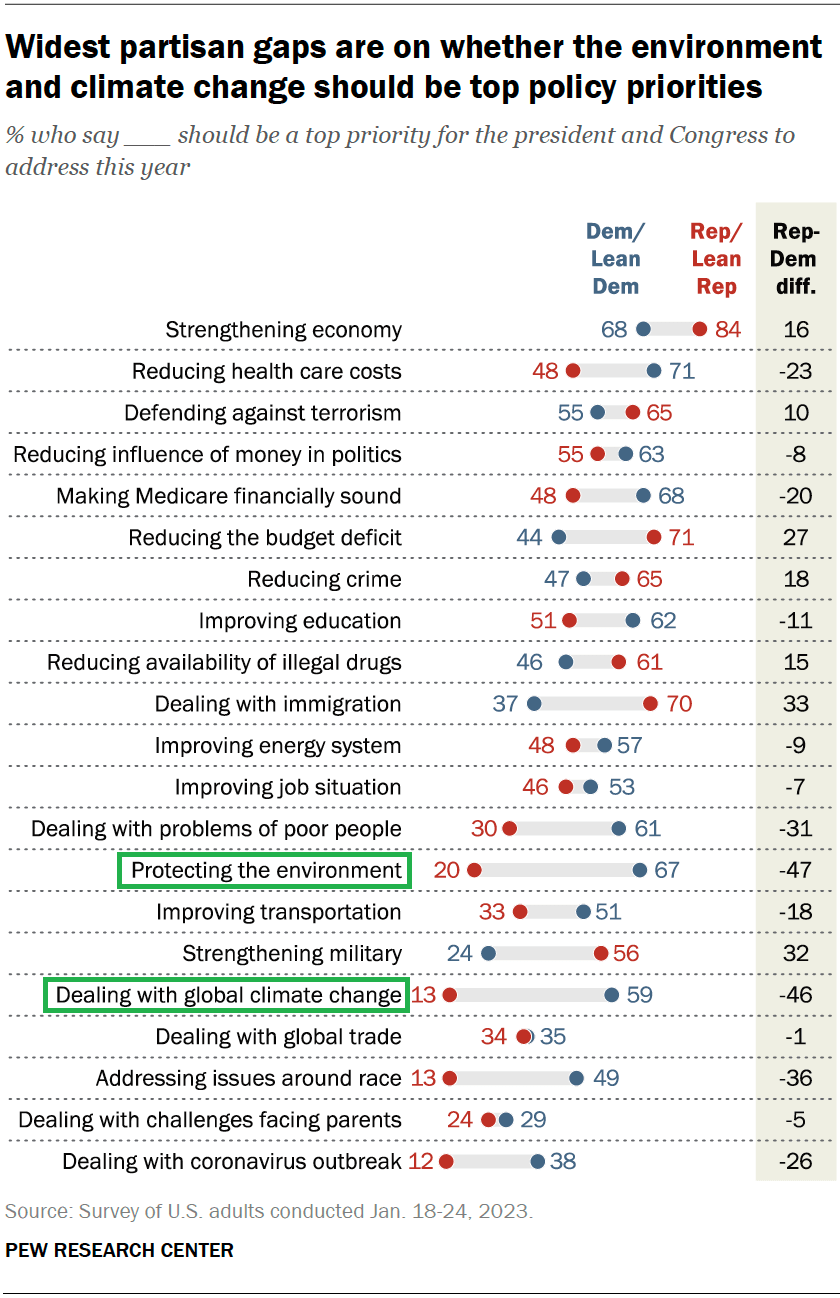
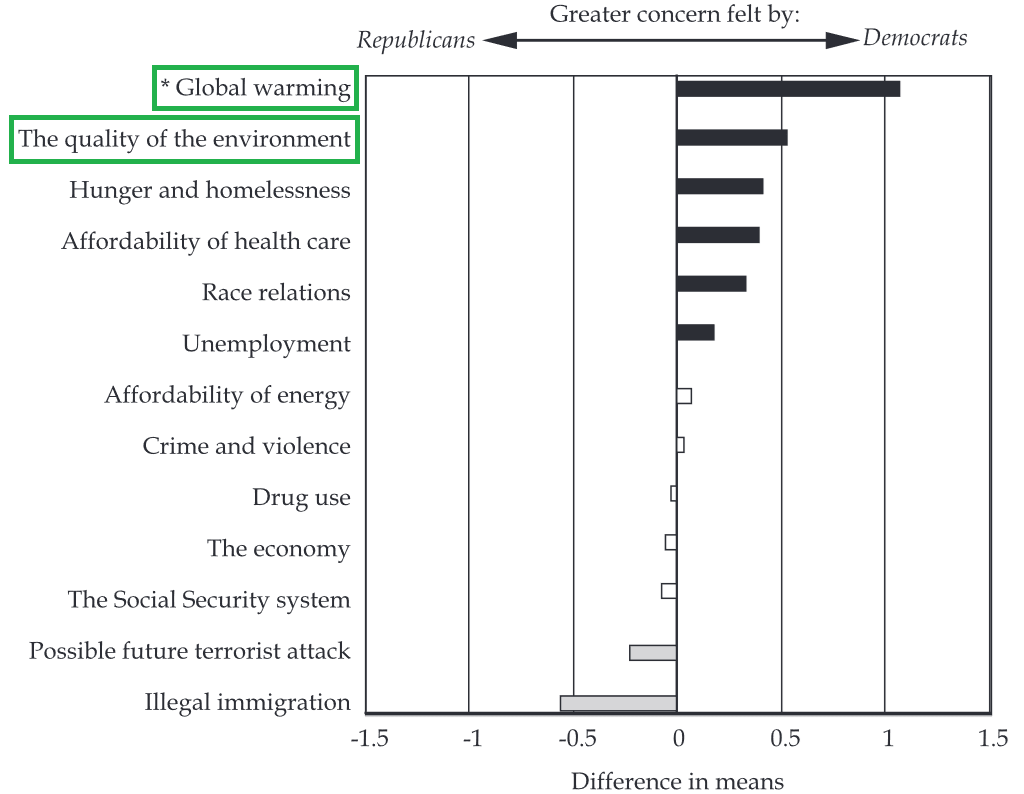
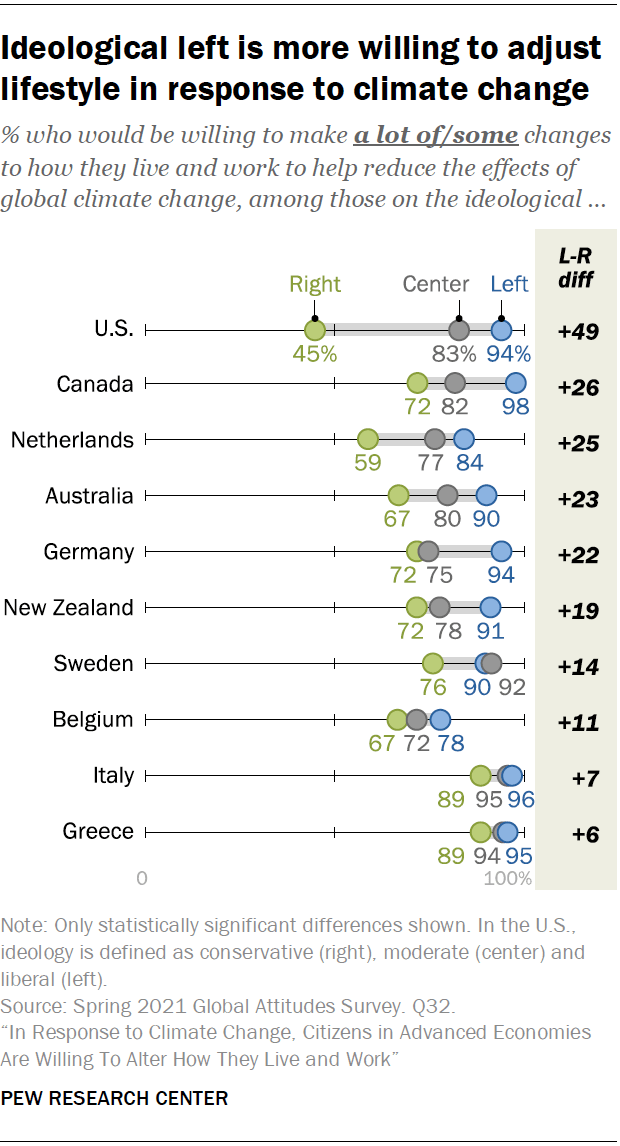
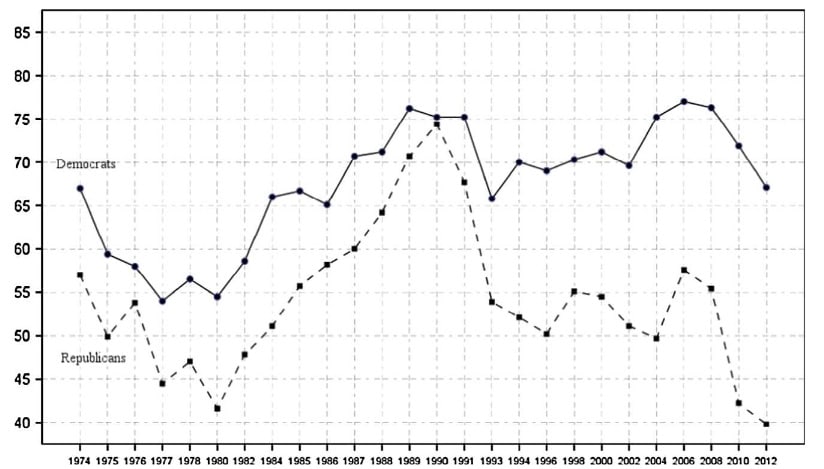
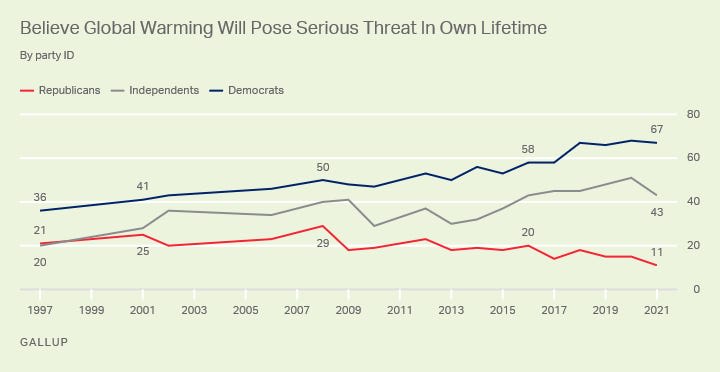
Executive summary: Environmentalism in the United States is unusually partisan compared to other issues, other countries, and its own history, suggesting that this partisanship is not inevitable but rather the result of contingent choices by individual decision makers.
Key points:
This comment was auto-generated by the EA Forum Team. Feel free to point out issues with this summary by replying to the comment, and contact us if you have feedback.
Thanks for this, fascinating stuff!
I am wondering from many of the data that you present and also anecdotally: Isn't it more that "climate change" is so strongly partisan, not environmental issues more broadly? And because climate change has become the dominant political environmentalist issue, "climate" and "environmentalism" become somewhat synonymous despite the underlying politics of other environmental issues being somewhat different?
Climate change is more partisan than other environmental issues, but other environmental issues have also become partisan since 1990.[1] The shift in focus from local environmental issues to climate change is part of what made it easier for environmentalism to become partisan, but it is not the only factor.
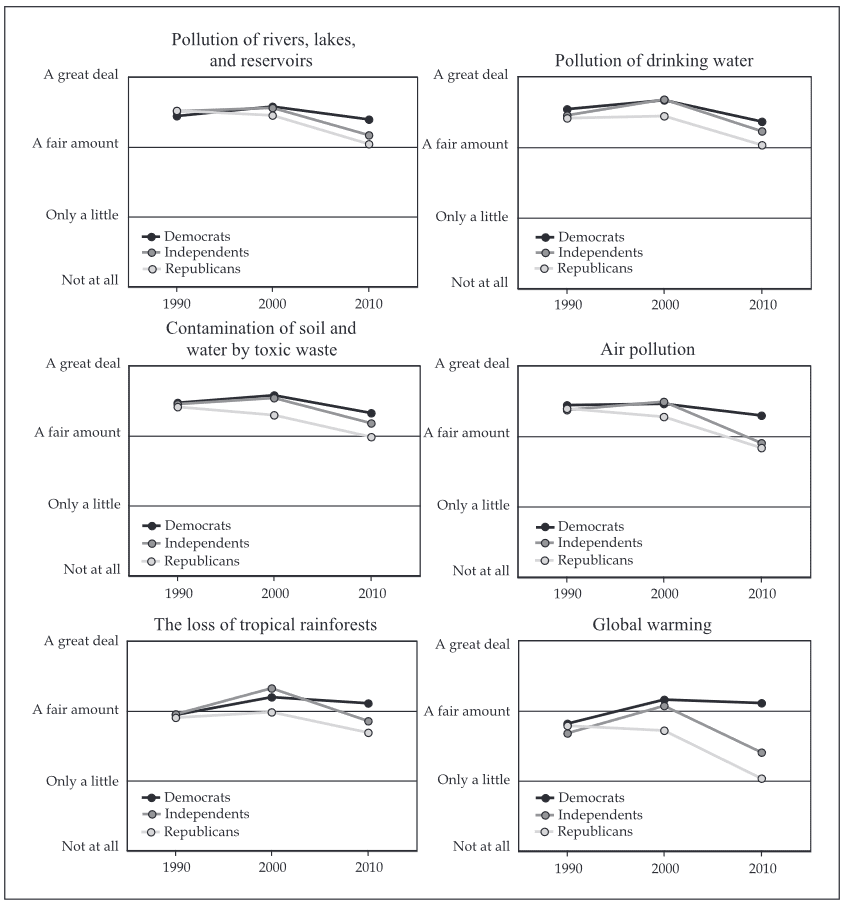
Environmental concern by partisan identification, averaged over a four point scale. “I’m going to read you a list of environmental problems. As I read each one, please tell me if you personally worry about this problem a great deal, a fair amount, only a little, or not at all.” Reprinted from Guber (2013).
Deborah Lynn Guber. A Cooling Climate for Change? Party Polarization and the Politics of Global Warming. American Behavioral Scientist 57.1. (2013) p. 93–115. https://cssn.org/wp-content/uploads/2020/12/A-Cooling-Climate-for-Change-Party-Polarization-and-the-Politics-of-Global-Warming-Deborah-Guber.pdf.